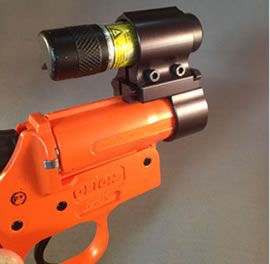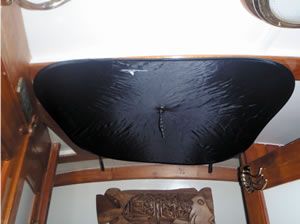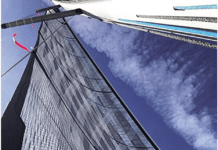Photos courtesy of makers

Laser rescue flares like those offered by Greatland Laser (see PS February 2004, March 2011, and September 2013 online) have long been marketed as a way to attract the attention of potential rescuers. One issue associated with their use has been accurate aiming to get the rescuers attention. The new Picatinny Mount Laser Flare Holder, made by North American Laser, aims to take the guesswork out of, well, aiming.
The standard method of aiming a laser flare has always been the same as that used with signal mirrors: The user brackets the target (rescuer) in the V of two fingers and slowly plays the beam back and forth. The Picatinny laser flare holder is essentially a two-piece bracket that allows users to mount any Greatland Rescue Laser to the barrel of an ORION 12 Gauge flare pistol. Made in the USA, the holder is machined out of anodized 6061 T3 Aircraft Aluminum.
Mounting the laser flare to the flare gun not only helps solve the aiming problems, it also keeps your laser flare in an easy to remember location and ready for instant use. The manufacturer states another favorite aiming technique is to look through the empty barrel of the flare gun while held at arms length. What you see through the barrel sees your signal, if the laser is turned on. Theres an aiming ridge along the top of the holder to help sight a target.
In an emergency, the laser flare is used to alert rescuers to your position, after which the aerial flare would be fired to confirm you are in distress. Once sighted, youd want to stop aiming or shooting flares, however random flashes from the laser flare could still be used to guide rescuers to your position.
Testers found the holder to be well designed and robustly constructed. Installation was straightforward and easy. All that is needed are two 6-32 Allen screws and an Allen wrench (provided). Testers also liked that the flare can be operated and batteries changed (if needed) while mounted.
To check the ease of aiming provided by the mount, we anchored two test boats approximately 1 mile apart and conducted aiming tests at both twilight and in complete darkness. We aimed in both the traditional manner (i.e. flare gun in the closed position, like shooting a pistol) and with the breach open, while looking through the barrel to center the target and aim. Both methods of aiming worked fine, and the laser was very visible, particularly while sweeping from side to side.
In the past, there has been some controversy over the use of laser flares and laser pointers to hail aircraft, as some lasers can damage pilots eyesight. North Americans laser flares use U.S. Food and Drug Administration-approved laser light technology and meets EN 60825-1 and Class 3R regulations, which means they wont blind rescue vessel or aircraft operators. Laser flares are not yet Coast Guard approved visual distress signals.
Bottom line: The concept is simple, and we like simple to use attention-getting devices in the event of an emergency. At $53, it would be a reasonably priced upgrade for those who already own a Greatland Laser and a good addition to the ditchbag or signaling kit.
Photos courtesy of makers

Forespars new clear polycarbonate hose connectors allow users to see whats flowing (or not flowing) through hoses, making it easier to pinpoint clogs. Black pipe and hose make it impossible to see whats going on inside a line, and in a traditional setup, troubleshooting a clog would mean taking off a hose clamp-or 10. Not so with the MarelonClear View Hose Connectors.
The clear plastic tailpipes and elbowseach become a visual inspection port, and allow you to figure out where the problem is, without removing yards of hose. Made byDuPont,the hose connectors areheavy-duty yetlightweight, and arent subject to electrolysis.
They are usable above or below the waterline, and they are compatible withmost marine raw-water intake strainers and valves.The hose connectors come with standard marine pipe thread on one end and a barbed fitting on the other. They usemarine standard NPSM (parallel) threads thatwork onallForespar Marelonwaterstrainers and valvesand other metal marine valves andfittings with NP parallel threads. Available in both straight and90-degree elbows in hose diameters ranging from half-inch to 2 inches, Clear View connectors can be adapted to most existing water systems but cannot be used with fuels, anti-freeze, or solvents. Prices range from $3.30 to $17.45.
Photos courtesy of makers


Spend any length of time in the forward cabin, and at some point, youll want at least two things (with regards to hatches anyway): a way to keep bugs out and a way to keep sunlight out of the cabin, either of which can ruin much needed sleep. Two products we recently reviewed from Swedish company Waterline Designs promise to meet these requirements, the Waterline Designs Mosquito Net (WM1220) and Blackout Curtain (W1510).
Mosquito Net
Traditional methods of bug-proofing the forward hatch include screens that either attach to the underside of the hatch (using Velcro or some similar arrangement) or are draped over the top of the open hatch. Weve used the latter option on our test boat for a number of years, but always found it a minor pain to have to go topsides to remove it. Waterline Designs net and blackout screen feature a cord and suction cup arrangement that allows you to attach them quickly and easily from downbelow, inside the cabin. The cord is attached to the suction cup, runs through a grommet in the center of the screen, then through an adjustable clamp. To install it on our test boat, we simply opened the V-berth hatch, attached the suction cup to the underside of the hatch glass, then secured the mosquito net in place by sliding the adjustable cord clamp up tight against the bottom of the net, creating a slight bow in the fabric. It was simple to install and stayed firmly in place.
The mosquito net is constructed of black polyester netting with a flexible, chromed steel frame. The netting is dense enough to keep small insects and gnats out, but is also breathable (for a minimal reduction in airflow). The net we tested is 20.5 inches square and is designed for hatches 20.5 by 20.5 inches or smaller. The larger version (31.5 inches square) fits hatches 27 5/8 x 27 5/8 inches or smaller. (It also features a two suction cup support arrangement for greater stability.) Theres also an 11.75- by 15.75-inch model for portholes.
Blackout Curtain
The blackout curtain provides 100-percent blackout and is also advertised as a thermal barrier, keeping cold/warm air inside/outside. Testers found the curtain to be well constructed, with a flexible, chromed steel frame and a PVC-based material that is a reflective silver on top and black on the bottom.
The blackout curtain is available in both regular (20.5 inches square) and large (27 5/8 inches square) hatch sizes, with port-hole models also available.
What we liked
Both the mosquito net and blackout curtain were super easy to install. They fold down to one-third of their full size and store easily in a compact, circular pouch. This not only makes for convenient storage aboard the boat, but also means they can be easily packed and carried for use when crewing on other boats or while chartering. We also like that the blackout curtain serves double duty by preventing prying eyes from roaming around the cabin while at the dock.
As for downsides, the first would be that the suction cups wont work on fiberglass hatches that are rough or uneven, although the manufacturer does offer a smooth disc that can be glued to the underside of the hatch for use as an attachment point. Another is that the blackout screen (which has a shorter cord) is designed for use while the hatch is closed, which means no air flow.
Bottom line: The mosquito net ($30) and blackout curtain ($34) performed as advertised and get the thumbs up from our testers. Both are distributed in the U.S. by Seoladair and are available for purchase on Seoladairs website and from a few online retailers such as Defender Marine (www.defender.com).





































